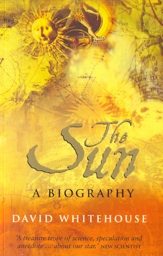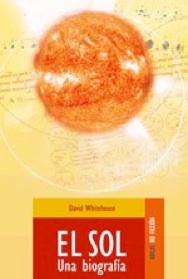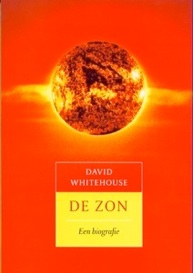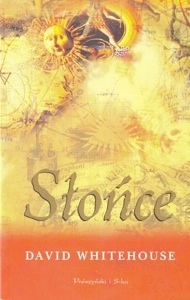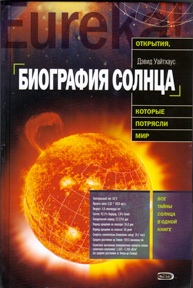- Home
- Moon
- Sun
- One Small Step
- Galileo
- Night
- Journey Centre Earth
- Apollo 11 - The Inside Story
- Space 2069
- Alien Perspective
The Sun: A Biography
…a staggering range of content …offering a plethora of facts and a fascinating read. Good Book Guide.
The Greek philosopher Anaxagoras thought the sun was a ball of red-hot iron bigger than the Peloponnese. William Herschel, who discovered the planet Uranus, believed that living beings dwelt inside the sun. In misty conditions, when the sun is greatly dimmed, it is possible to see large sunspots with the naked eye. All these facts I gleaned from David Whitehouse's book, The Sun: A biography.
The successor to his The Moon: A Biography, it is a treasure trove of science, speculation and anecdote about our star. Whitehouse touches on everything from the birth of the sun in a cold interstellar cloud to its predicted death as a bloated red giant. He covers the sunspot cycle and the nature of auroras, the solar neutrino mystery and the puzzle of coronal heating.
Whitehouse appears to have explored every possible avenue, and I can only guess at the enormous amount of research this must have required. What next, I wonder? Mars: A biography? The question, after this feat, is whether he will be able to summon the strength. New Scientist.
Reading this...immensely entertaining work of pop science makes us aware of...the power of the sun. The Herald, Glasgow.
An intelligent safety-goggles-on look at [a] star that's intrigued humankind since day one...wide-ranging and excellent. Insight.
This is a comprehensive biography of the sun written by the leading BBC journalist David Whitehouse. Since man first became conscious he has sought to understand the nature of the sun; he has worshiped it, been inspired to produce great art about it, researched it and even died for it. Understanding the nature of the sun is key to understanding our universe and to life on earth. Whitehouse skillfully weaves his extraordinary scientific knowledge with history, philosophy, archeology and religion to produce this fascinating account of the life and future of the sun. Aakdemia - Germany.
After the Moon David has now moved slightly further away and tackled out local star, the Sun. Both books skillfully target the interest of the general reader. Both have similar clarity and succinctness. Both abound with many an amusing turn of phrase. They are interesting, enthralling, throughout, and easy to read.…the birth, life, and death of the Sun are carefully considered, exactly as you would expect in any excellent biography, which is exactly what this book is. The Observatory.
Whitehouse has done an outstanding job. The Sunday Telegraph.
The Sun: A Biography, written by the science correspondent for the BBC, presents an account of the history of the study of the Sun and its significance. This is a well written and enjoyable account of the importance of this object in our lives, what we know about our nearest star and - just as important - how we know it. A particular strength of the book is that it places this knowledge in its social context, showing how such understanding contributed to the cosmologies of the time. Given that research shows that astronomy is the one science topic that engages all pupils, this book will form a useful addition to any teacher's fount of knowledge . Times Educational Supplement.
The Sun: A Biography covers a remarkable array of subjects from the historical to the scientific, the mythological to the personal. David Whitehouse leads off with a story about Air Force One losing touch with the outside world while crossing the Pacific Ocean in 1984. The culprit? Intense “space weather” associated with a string of sunspots in Active Region 4474. The ways in which the Sun can affect the modern world have become increasingly complex, but its role as a central heavenly body (in more ways than one) forms the foundation of the book.
Jumping back and forth in time, the book balances a topical arrangement with a distinct chronological order. The interlocking narrative first becomes apparent somewhat incongruously in the form of interstitial images that appear between each chapter. Whitehouse leads with subjects such as “the Goldilocks star” and a brief history of the universe, but the images that separate the chapters include a Celtic glyph depicting an eclipse and a relief showing “the four-pointed disk of Shamesh.” By the time archaeological records get addressed in the text, we’ve already seen pictures that have introduced the topic.
A rich history of the Sun’s influence on humanity extends back for millennia, and Whitehouse lavishes loving attention on everybody from the Babylonians to the Chinese, from the Irish to the Aztecs. Once we get past the Scientific Revolution, a plethora of observations bolster the central story, which continues to explore human understanding of our parent star.
We learn about Thomas Harriot’s 1610 drawing of sunspots, Giovanni Cassini’s highly accurate 1672 estimate of the Sun’s distance, John Winthrop’s 1761 observations of the transit of Venus, the first complete telling of the remarkable and tragic story of Richard Carrington following his 1859 recording of a visible solar flare - the list goes on and on. Whitehouse tracks the divergent events and ideas with the dogged determination of a scientific sleuth resolved to turn up every available clue about the Sun and its history. Characterized by lengthy asides and digressions, Whitehouse’s style nonetheless manages to entertain and engage without losing the core narrative. In many ways, The Sun feels like a reference book, yet it reads quite easily and enjoyably.
Although history plays an important role, the science and understanding of the Sun holds center stage, and a staggering amount of current science gets worked into the account: thermonuclear fusion, sure, but also the solar dynamo, space weather, and stellar evolution, to name just a few.
Despite the lengthiness of his book, Whitehouse manages brief and accurate explanations of complex topics. For example, a few simple sentences connect the magnetic loops of material (seen in ultraviolet and X-ray images of the Sun) with sunspots seen in visible light: “In the regions of high magnetic field, the outward flow of energy is impeded and a cooler region ensues where the loops appear, often in pairs. Welcome to a sunspot.” It’s hard to get more succinct than that.
Whitehouse, a longtime BBC News Online science editor and European Internet Journalist of the Year in 2002, makes his American debut with The Sun (an earlier “biography” of the Moon has not appeared in the United States). If he has the wherewithal to maintain the momentum established in this book, we can expect great things in the future. He has provided us with a spectacularly detailed written portrait of the Sun: rife with historical and scientific details, a story materializes about not just the detailed nature of Earth’s parent star, but also about the process by which science proceeds and the methodology of discovery. The Planetarian.
Your view of the sun and your appreciation of it will be changed forever. The Sun: A Biography is not only an informative read, it is also highly entertaining as well. Net Resources
